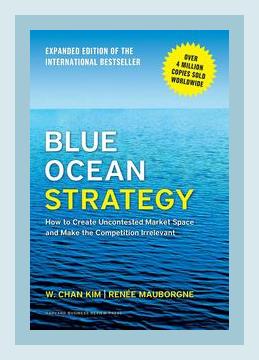Business StrategyBlue Ocean Strategy
**
Introduction
In “Beyond Competition: Crafting Blue Ocean Strategies,” Nathaniel Hughes presents a detailed guide on how businesses can break free from the competitive red ocean and create uncontested market space called blue oceans. Employing robust real-world examples and actionable advice, Hughes breaks down the core principles of Blue Ocean Strategy and outlines steps for businesses to innovate, differentiate, and thrive without the cutthroat competition.
Main Points & Actionable Steps
1. Understanding Red and Blue Oceans
Hughes begins by elaborating on the differences between red and blue oceans, drawing on the primary tenets introduced by W. Chan Kim and Renée Mauborgne. Red oceans symbolize existing industries where rivalry is fierce, leading to declining profits and growth. Conversely, blue oceans signify uncharted territories ripe with opportunities.
Actionable Step:
– Conduct a Market Analysis: Regularly analyze your industry to identify signs of overcrowded markets (red oceans) versus unexplored opportunities (blue oceans).
Example:
Hughes discusses Apple’s creation of the iPod, a blue ocean move that transcended the saturated personal audio market.
2. Value Innovation
Central to creating blue oceans is the idea of value innovation, enhancing value for customers while reducing costs. This contradicts the conventional belief that companies must choose between differentiation and low cost.
Actionable Step:
– Map Value Curve: Create a strategic canvas and plot your company’s and competitors’ offerings. Identify factors that can be eliminated, reduced, raised, or created to uniquely position your product.
Example:
Cirque du Soleil amalgamated circus and theater to remove expensive animal acts and stars, focusing instead on a unique storyline and performing arts.
3. Formulating Blue Ocean Strategy
Hughes provides a comprehensive framework for formulating a blue ocean strategy, emphasizing six key principles:
1. Reconstruct market boundaries.
2. Focus on the big picture, not the numbers.
3. Reach beyond existing demand.
4. Get the strategic sequence right.
5. Overcome organizational hurdles.
6. Build execution into strategy.
Actionable Step:
– Use the Six Paths Framework: Look beyond existing industry boundaries by exploring alternatives, strategic groups, buyer groups, complementary offerings, functional-emotional orientation, and future trends.
Example:
Nintendo’s Wii disrupted the gaming industry by targeting non-gamers and family segments, simplifying technology, and emphasizing interactive fun.
4. Creating and Capturing New Demand
To unlock new demand, Hughes recommends looking across non-customers and understanding their pain points. He categorizes non-customers into three tiers to explore untapped potential.
Actionable Step:
– Non-Customer Identification: Identify three tiers of non-customers—soon-to-be, refusing, and unexplored—and devise strategies to convert them to your market.
Example:
Yellow Tail wine recognized that many beer and cocktail drinkers avoided wine due to its complexity. By simplifying its branding and taste profile, it converted non-customers and dominated the U.S. wine market.
5. Differentiation through Simplification
Hughes highlights the importance of simplifying offerings to stand out in cluttered markets. This involves streamlining your product or service, making it more accessible and appealing.
Actionable Step:
– Product Simplification: Evaluate your product features and focus on those that provide significant value. Eliminate unnecessary complexity that does not enhance the user experience.
Example:
Southwest Airlines simplified air travel by removing in-flight meals and seat assignments, focusing on low cost and punctuality, which attracted price-sensitive customers.
6. Overcoming Key Organizational Hurdles
Transitioning to a blue ocean requires overcoming cognitive, resource, motivational, and political hurdles within the organization. Hughes identifies methods to address these challenges effectively.
Actionable Step:
– Tipping Point Leadership: Identify influential insiders who can drive changes and focus on critical actions that yield high impact with low resource input.
Example:
During their Blue Ocean shift, Surf Air cultivated early adopters, turning customers and partners into advocates, paving the way for a subscription-based private air travel model.
7. Building a Strategy Execution Culture
Implementing blue ocean strategies requires embedding execution into strategy at the onset. Hughes suggests setting up feedback loops and maintaining a flexible approach to adapt to market conditions.
Actionable Step:
– Embed Fair Process: Use fair processes that involve engagement, explanation, and expectation clarity to ensure team buy-in and commitment during strategy execution.
Example:
Intuit’s “follow-me-home” program involved employees visiting customers to observe usage and gather direct feedback, ensuring continuous improvement and alignment.
8. Sustaining Blue Ocean Strategy
Sustaining a blue ocean requires vigilance and proactive measures to counteract imitation and market changes. Hughes details how to fortify your position through constant innovation.
Actionable Step:
– Continuous Innovation: Implement a culture of continuous innovation by setting aside resources for R&D and encouraging an entrepreneurial mindset among employees.
Example:
Tesla recurrently releases software updates and new features to maintain a competitive edge and keep their products compelling and technologically advanced.
9. Risk Mitigation and Realignment
Hughes underscores the importance of managing risks associated with blue ocean initiatives. This involves periodic realignment and reassessment to ensure consistent value delivery.
Actionable Step:
– Scenario Planning: Develop multiple future scenarios to anticipate changes and prepare strategic responses. Regularly review and adjust your strategy based on market feedback and new data.
Example:
Netflix pivoted from DVD rentals to streaming and then to content creation, continuously realigning its strategy to stay ahead of market shifts and competition.
Conclusion
Nathaniel Hughes’ “Beyond Competition: Crafting Blue Ocean Strategies” serves as an essential guide for businesses eager to escape the bloodbath of red oceans and carve out new, innovative markets. By leveraging value innovation, understanding non-customers, simplifying offerings, overcoming organizational hurdles, embedding execution into strategy, and maintaining continuous innovation, companies can effectively craft and sustain blue ocean strategies. Hughes’ emphasis on practical steps and real-world examples ensures that businesses of all sizes can grasp and implement these principles for long-term success.
This structured approach provides a roadmap for leaders to not just survive but thrive by creating uncontested market spaces and delivering unparalleled value to customers.
